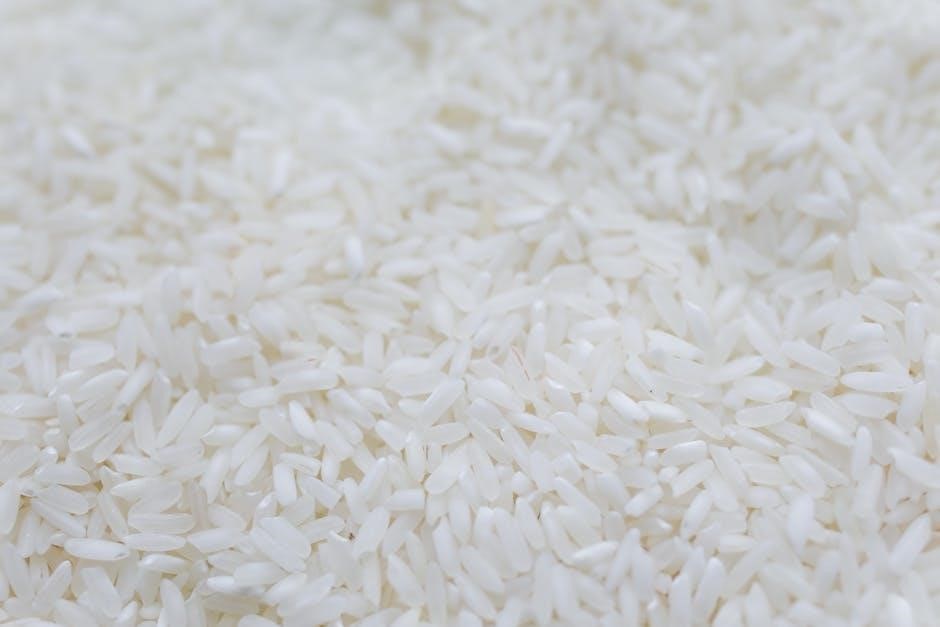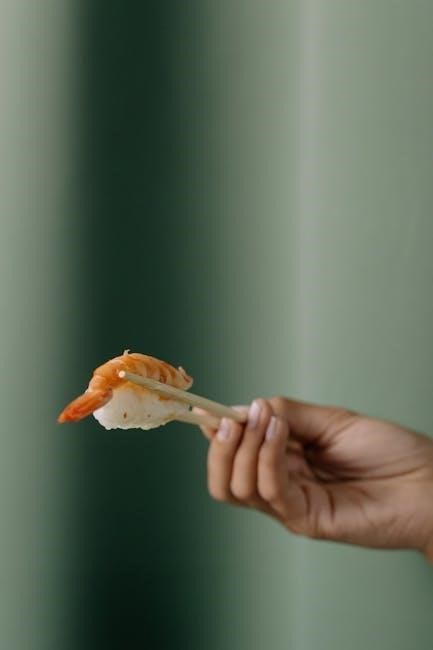Rival Rice Steamer Instructions: A Comprehensive Guide
Unlock the full potential of your Rival rice steamer with this comprehensive guide. We’ll explore models like the RC61 and 4450, offering step-by-step instructions for perfect rice and steamed dishes every time.
Rival rice steamers offer a convenient and efficient way to cook rice and steam various foods. These appliances are designed for ease of use, allowing you to prepare meals with minimal effort. Rival steamers, like model 4450, often include features such as automatic shut-off and versatile steaming baskets for vegetables, fish, and more.
This guide will walk you through the essentials of using your Rival rice steamer, from initial setup to troubleshooting common issues. Whether you’re a seasoned cook or a beginner, mastering your Rival steamer will elevate your culinary experience. Discover the simplicity and health benefits of steaming with Rival;
Understanding Rival Rice Steamer Models
Rival offers various rice steamer models, each with unique features. Knowing your model is crucial for proper operation. This section helps you identify and understand the specifics of your Rival rice steamer.
Common Rival Rice Steamer Models (e.g., RC61, 4450, CKRVRCM063)
Let’s explore some common Rival rice steamer models. The RC61, a 6-cup cooker with steamer, is popular. The Rival 4450 is an automatic steamer and rice cooker, offering versatility. The CKRVRCM063 is another 6-cup option. Each model has slightly different operating instructions and features. Understanding your specific model ensures optimal cooking results. Manuals for these models are often available online, offering detailed guidance. Knowing the model number allows you to find specific instructions and troubleshooting tips; Always refer to your model’s manual for the best results when cooking.

Initial Setup and Preparation
Before steaming, precise measurement of rice and water is vital. Washing the rice beforehand removes excess starch, preventing stickiness. These steps are crucial for achieving perfectly cooked rice.
Measuring Rice and Water Ratio
Achieving the correct rice to water ratio is paramount for fluffy, well-cooked rice in your Rival steamer. Generally, a 1:1 or 1:1.5 ratio (rice:water) works well, but consult your specific model’s manual (e.g., RC61, 4450) for precise instructions. Using the measuring cup provided with your Rival rice cooker ensures accuracy. Remember that different types of rice (white, brown, basmati) may require slightly adjusted ratios. Too little water results in undercooked rice, while too much leads to a mushy consistency. Experimentation, guided by your model’s manual, will help you discover the perfect ratio for your preferred rice type and desired texture.
Washing the Rice
Before adding rice to your Rival steamer, washing it is crucial for optimal texture and flavor. Washing removes excess starch, preventing the rice from becoming sticky or gummy during cooking. Place the measured rice in a separate bowl and cover it with cool water. Gently swirl the rice with your hand until the water becomes cloudy. Drain the cloudy water and repeat this process several times until the water runs clear. This typically requires 3-4 washes. Removing the starch also helps prevent the rice from sticking to the bottom of the Rival steamer’s bowl, making cleanup easier.

Operating Instructions
Follow these steps to operate your Rival rice steamer effectively. Learn how to add water, place food in the basket, set the timer, and start the cooking process for delicious results.
Adding Water to the Reservoir
Before commencing the steaming process with your Rival rice steamer, it is crucial to add the correct amount of water to the reservoir. This water will be heated to create steam, which cooks the rice or other food items placed in the steamer basket. Refer to your Rival model’s instruction manual, such as the 4450 or RC61, to determine the precise water level required. Usually, a measuring cup is provided for accuracy. Ensure the water level does not exceed the maximum fill line indicated within the reservoir. Insufficient water can lead to undercooked food, while excessive water may cause overflow or damage to the unit.
Placing Food in the Steamer Basket
After adding water to the reservoir of your Rival rice steamer, carefully place the food you intend to steam into the steamer basket. Ensure the food is evenly distributed within the basket to promote uniform cooking. Avoid overcrowding the basket, as this can hinder steam circulation and result in unevenly cooked food. For optimal results, cut larger vegetables or proteins into smaller, manageable pieces. If steaming multiple types of food, consider their respective cooking times and layer them accordingly, placing items requiring longer cooking times at the bottom of the basket. Always consult your Rival steamer’s manual for specific recommendations regarding food placement and steaming times. Remember to use the rice bowl for rice or dishes with sauce.
Setting the Timer (If Applicable) or Starting the Cooking Process
Once the water is added to the reservoir and food is properly placed in the steamer basket of your Rival rice steamer, it’s time to initiate the cooking process. If your model features a timer, consult the user manual to determine the appropriate steaming time for your chosen ingredients. Set the timer accordingly. For models without a timer, simply plug the steamer into a 120-volt AC electrical outlet to begin the cooking cycle. The Rival steamer will automatically shut off once the water has evaporated, signaling the end of the steaming process. Never operate the rice cooker uncovered, as steam can cause burns. Monitor the cooking, especially the first few times, to adjust timing for future use.

Cleaning and Maintenance
Proper cleaning is essential for your Rival rice steamer’s longevity. Regularly clean the rice bowl and steamer basket to prevent residue buildup. This ensures optimal performance and prevents unwanted flavors from affecting future meals.
Cleaning the Rice Bowl and Steamer Basket
To maintain your Rival rice steamer, cleaning the rice bowl and steamer basket is paramount; After each use, allow the components to cool completely before washing. Use warm, soapy water and a non-abrasive sponge to gently remove any stuck-on food particles. Avoid using harsh chemicals or scouring pads, as these can damage the non-stick coating of the rice bowl or the plastic of the steamer basket.
Rinse thoroughly with clean water and dry completely before reassembling. For stubborn residue, soaking the bowl in warm soapy water is recommended. Regular cleaning will prevent buildup, ensuring optimal cooking performance and prolonging the life of your appliance.
Troubleshooting Common Issues
Experiencing issues with your Rival rice steamer? This section addresses frequent problems, offering solutions for undercooked or overcooked rice, and resolving issues with the steamer not turning on.
Rice is Undercooked or Overcooked
Encountering rice that’s either too hard or too mushy is a common frustration. For undercooked rice, add a bit more water (about 1/4 cup) and continue steaming for a few more minutes, checking frequently. Ensure the steamer is on a level surface. Conversely, if the rice is overcooked and mushy, reduce the water ratio in your next attempt. Also, make sure that you are measuring the ingredients in the correct way. Slight variations can have an impact on the consistency of the rice. Always follow the recommended water-to-rice ratio provided in your Rival rice steamer’s manual.
Steamer Not Turning On
If your Rival rice steamer refuses to power on, begin by verifying the power cord is securely plugged into both the steamer and a functioning electrical outlet. Check the outlet with another device to confirm it’s providing power. Examine the power cord for any signs of damage, such as fraying or cuts, and replace it if necessary. Some models have a reset button; consult your manual to locate and press it. If the issue persists, the heating element or internal circuitry may be faulty, requiring professional repair or replacement of the unit. Make sure the steamer is assembled correctly before attempting to turn it on.

Recipes and Cooking Tips
Discover delicious possibilities beyond rice! Explore recipes for steaming vegetables, fish, and more in your Rival steamer. Learn tips for perfectly cooked dishes and creative meal ideas to expand your culinary repertoire.
Steaming Vegetables, Fish, and Other Foods
Beyond rice, your Rival steamer excels at cooking various foods. For vegetables, ensure uniform sizes for even cooking. Delicate fish fillets steam beautifully with lemon slices and herbs. Experiment with dumplings or tamales, adjusting cooking times as needed. Remember to place foods in the steamer basket, preventing direct contact with water.
Consult online resources for specific steaming times for different ingredients. Always monitor the water level in the reservoir and replenish if necessary. A little practice will make you a steaming pro, creating healthy and flavorful meals effortlessly. Enjoy the versatility of your Rival steamer!
Safety Precautions
Prioritize safety when using your Rival rice steamer. Handle the appliance with care to prevent burns from steam. Ensure proper cord handling and storage to avoid electrical hazards.
Avoiding Burns from Steam
Steam burns are a significant risk when using any rice steamer, including Rival models. Always exercise caution when operating the appliance. Never open the lid abruptly during the steaming process, as hot steam will rapidly escape. Use oven mitts or heat-resistant gloves when handling the hot rice bowl or steamer basket after cooking. Keep your face and hands away from the steam vent to prevent accidental burns. Allow the steamer to cool down completely before attempting to clean or disassemble it. Supervise children closely when the steamer is in use to ensure their safety. Remember, steam can cause severe burns, so prioritize safety at all times.
Proper Cord Handling and Storage
Safe cord handling and storage are vital for the longevity of your Rival rice steamer and your safety. Always unplug the steamer from the electrical outlet before cleaning or storing it. Avoid pulling the cord to disconnect it; instead, grasp the plug firmly. Never use the steamer if the cord is damaged. When storing, do not wrap the cord tightly around the appliance, as this can damage the wires. Keep the cord away from heat sources and sharp edges. Store the steamer in a cool, dry place. Ensure the cord is fully extended during operation to prevent overheating and potential fire hazards.
